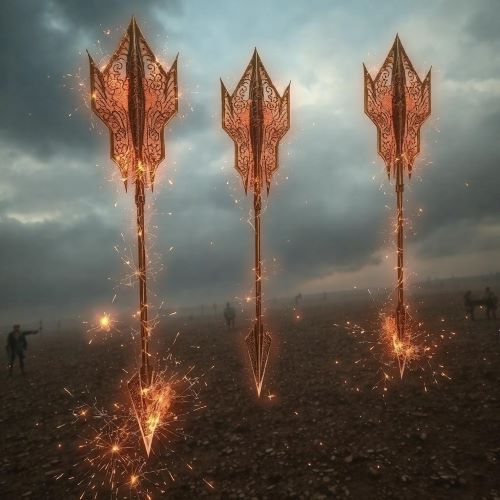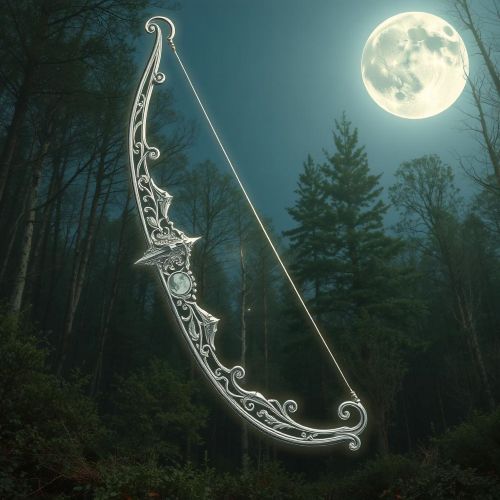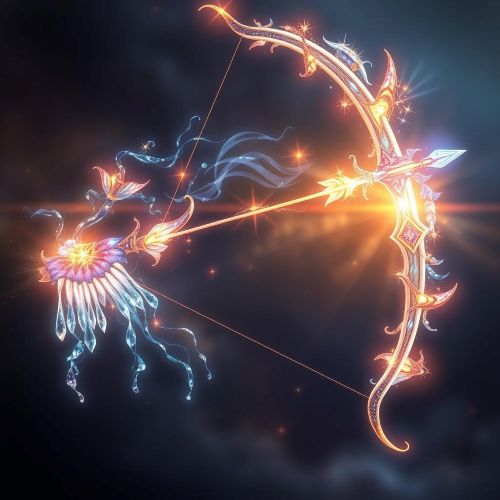Sekhmet’s Arrows : The Fiery Wrath
Sekhmet’s Arrows
Introduction
In ancient Egyptian mythology, few figures are as fierce and enigmatic as Sekhmet, the lion-headed goddess of war and healing. Her presence invoked awe and reverence—described as a force of both devastation and restoration. Central to her mythos are Sekhmet’s Arrows, divine instruments that encapsulate her dual essence. Seen not merely as weapons but as metaphysical symbols of wrath and remedy, these arrows served as messengers of plagues or shields of protection, depending on Sekhmet’s will. Their purpose wasn’t random destruction but a cosmic response to imbalance.
Origins
The origins of Sekhmet’s Arrows trace back to one of Egypt’s oldest creation myths involving the Eye of Ra. When humanity rebelled against the sun god Ra, he conjured Sekhmet from his own eye to punish them. What followed was a rampage across Egypt where her arrows—depicted metaphorically as plagues or burning desert winds—laid waste to those who broke divine order. These arrows were believed to be spiritual manifestations, not physical weapons. They acted as the extension of Ra’s will, with Sekhmet delivering his judgment to the mortal world.
Over time, these arrows came to symbolize the thin line between divine justice and chaos. Their invocation in ancient rituals, especially around the New Year when spirits were thought to roam freely, shows how embedded they were in Egyptian spiritual practice. Texts such as the “Book of the Last Day of the Year” referenced these arrows directly, reflecting both fear and reverence.
Think you know your myths and legends? Dive into the world of ancient stories and test your knowledge with our engaging quizzes on Mythlok!
Powers
The powers attributed to Sekhmet’s Arrows are as complex as the goddess herself. They weren’t just tools of destruction—they embodied the energy of the sun, capable of incinerating those who challenged the gods. Many ancient Egyptians believed that diseases, especially epidemics, were manifestations of these arrows in action. Their damage wasn’t indiscriminate; Sekhmet’s divine insight meant her arrows struck only those guilty of disrupting Ma’at—the fundamental order and balance of the universe.
However, the same forces that caused illness could also bring healing. Priests of Sekhmet, known as powerful healers, believed that by understanding the nature of her arrows, they could wield them in reverse—drawing out sickness and returning the body to harmony. In this way, the arrows represented not only punishment but purification, emphasizing that healing often required a confrontation with imbalance first.
Owners/Users
Although Sekhmet’s Arrows were her own divine instruments, their reach extended beyond her direct hand. While no mortal could physically wield these weapons, they were believed to act through intermediaries—spirits, demons, or even natural forces like desert winds and seasonal changes. In certain texts, these agents are referred to as the “Seven Arrows”—each representing a unique aspect of divine wrath such as fever, madness, or drought.
Pharaohs, in particular, were seen as under Sekhmet’s special protection. They didn’t use the arrows themselves but were thought to command their favor through ritual. In warfare, kings often invoked Sekhmet before battle, believing her arrows would weaken or confuse their enemies. Her priests performed elaborate ceremonies in temples—especially during times of unrest or illness—to either redirect the arrows’ destructive path or invite their protective shield over the land.
Instances used
Sekhmet’s Arrows appear throughout both mythological stories and historical traditions, always serving as symbols of divine reaction. The most famous account is from the myth “The Destruction of Mankind.” In this tale, Sekhmet’s rage threatens to obliterate humanity after being unleashed by Ra. As she moves across the land, her arrows decimate entire regions, representing plagues and suffering. Only after she is tricked into drinking beer dyed red to resemble blood does her fury subside—suggesting the only way to disarm such divine power is through deception and ritual.
Outside mythology, these arrows were believed to be active forces in the real world. Outbreaks of disease or misfortune were commonly attributed to their influence. During festivals marking the end of the year—a vulnerable period spiritually—amulets and prayers were used to shield families from their impact. In military contexts, reliefs and inscriptions show pharaohs calling upon Sekhmet to hurl her arrows at foreign enemies, blurring the line between myth and state propaganda.
One particularly notable instance involves Pharaoh Amenhotep III, who commissioned over 700 statues of Sekhmet. Scholars believe this massive effort was not only a gesture of reverence but also a plea for her arrows to be stayed during periods of disease and political instability.
Frequently Asked Questions
Lorem ipsum dolor sit amet, consectetur adipiscing?
Lorem ipsum dolor sit amet, consectetur adipiscing elit. Praesent convallis vestibulum justo, ac tincidunt nunc vehicula quis. Nullam id dolor quis orci malesuada feugiat. Curabitur aliquet libero at urna ullamcorper, ac ultricies nulla dapibus.
Lorem ipsum dolor sit amet, consectetur adipiscing?
Lorem ipsum dolor sit amet, consectetur adipiscing elit. Praesent convallis vestibulum justo, ac tincidunt nunc vehicula quis. Nullam id dolor quis orci malesuada feugiat. Curabitur aliquet libero at urna ullamcorper, ac ultricies nulla dapibus.
Lorem ipsum dolor sit amet, consectetur adipiscing?
Lorem ipsum dolor sit amet, consectetur adipiscing elit. Praesent convallis vestibulum justo, ac tincidunt nunc vehicula quis. Nullam id dolor quis orci malesuada feugiat. Curabitur aliquet libero at urna ullamcorper, ac ultricies nulla dapibus.
Lorem ipsum dolor sit amet, consectetur adipiscing?
Lorem ipsum dolor sit amet, consectetur adipiscing elit. Praesent convallis vestibulum justo, ac tincidunt nunc vehicula quis. Nullam id dolor quis orci malesuada feugiat. Curabitur aliquet libero at urna ullamcorper, ac ultricies nulla dapibus.
Lorem ipsum dolor sit amet, consectetur adipiscing?
Lorem ipsum dolor sit amet, consectetur adipiscing elit. Praesent convallis vestibulum justo, ac tincidunt nunc vehicula quis. Nullam id dolor quis orci malesuada feugiat. Curabitur aliquet libero at urna ullamcorper, ac ultricies nulla dapibus.
Watch
Source
Henadology. (2009). Sekhmet. Retrieved from https://henadology.wordpress.com/theology/netjeru/sekhmet/
Archaeology Magazine. (2025, January 7). The World of Egyptian Demons – Demon Archers. Retrieved from https://archaeology.org/issues/may-june-2022/collection/demon-archers-of-the-lion-goddess/the-world-of-egyptian-demons/
Ancient Egypt Online. (2001). Discover Sekhmet: Goddess of Retribution and Protector of Egypt. Retrieved from https://www.ancient-egypt-online.com/sekhmet.html
Avid Archer. (2024, October 9). Sekhmet Egyptian Goddess of War & Healing. Retrieved from https://avid-archer.com/sekhmet-egyptian-goddess-of-war/
The Paganista. (2024, November 21). Sekhmet. Retrieved from https://www.thepaganista.com/blog/sekhmet
Centre of Excellence. (2024, July 16). Sekhmet in Egyptian Mythology: Myths, Symbols, and Powers. Retrieved from https://www.centreofexcellence.com/sekhmet-in-egyptian-mythology/
Tales from the Two Lands. (2020, September 1). She Who Is Powerful. Retrieved from https://talesfromthetwolands.org/2020/09/01/she-who-is-powerful/








